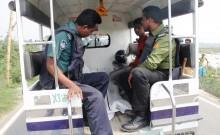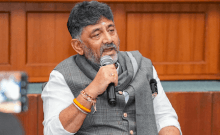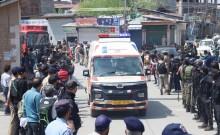I was there, they were killing and I watched. Then I started trembling. These are the words of Angela Wabingwa, a young woman who survived a massacre in her town of Ndalya in the Democratic Republic of Congo (DRC)s eastern province of Ituri, on the edge of Eringetis forest.
Speaking from Beni in the North Kivu province (a two-hour journey from her village), where she found refuge after fleeing Ndalya, Angela told IBTimes UK how her two younger brothers, aged 15 and 18, were slaughtered in front of her during an attack in August 2015.
The president of the civil society of Beni has been recording some of the worst massacres in the countrys recent history since they started in October 2014. According to Kizito Bin Hangi, more than 1,110 people have been killed and kidnapped in the territories of Beni, Butembo and Lubero in North Kivu. Thousands have been displaced, and hundreds have simply been kidnapped – and have disappeared without trace.
I was in the town of Ndalya and I saw the [armed attackers] arrive. They said hello to me and asked where they could find drinks. I told them it was [sold] over there. They told children they were starting work, and I started doubting which work they were talking about. They started killing young boys in front of me, children aged nine or 10, Angela explains.
Angela, aged 23, says she believes a female assailant spared her because she had been carrying her two-week old baby when the attack took place. Among the attackers, a woman asked me to flee so I wouldnt get slain. Then I fled. With my baby in my arms, she recalls.
Nineteen people were killed with machetes and axes in front of her that day – men, women and children. Ironically, there were men, women and children – the youngest I think must have been eight or nine – among the attackers, who Angela could only describe as sounding foreign to the region.
No later than this week, a man escaped death because of his dogs.
While he could not be identified, the man explained he had been out in the fields with his dogs when the attackers tried to tie him up. The dogs attacked and bit the armed men. Thats how I escaped and got to Beni, he said.
Children among unidentified killers
Since the massacres began, more than 21 months ago, Hangi – the first vice-president of Benis branch of main DRC human rights group, ASADHO – has been taking testimonies from survivors to prepare reports before handing victims over to security forces.
Confirming Angelas story, Hangi explained women and children have often been among the armed assailants, who generally enter a village making loud noises – whistling, beating a sort of drum – after which they tie-up whoever they have captured and start slitting their throats. Often, members of the same family are slaughtered; parents now remain without their families, children without parents. Fearful survivors also reported looting of property, equipment and animals: goats and hens.
Until May 2016, the attackers have, at times, managed to kill up to 50 people in some villages with weapons – machetes and hoes, mainly – as well as firearms, he said. Surprisingly, however, and despite the large number of attacks, the identity of the attackers remains uncertain.
In testimonies it has recorded, ASADHO has also found that attackers spoke Swahili, Kiganda –Ugandas language – and Kinyarwanda, the language of Rwanda. Rwandas closest border town of Gisenyi is a seven-hour drive to Beni, while the Ugandan border town of Katuna is six-and-a-half hours away.
Evidence points to rebels and Congolese army
Residents were led to believe that the Kinyarwanda-speaking attackers may have been former members of the North Kivu-based Congolese rebel group M23. Indeed, they said, the authorities failed to roll out any solid Disarmament, Demobilisation and Reintegration of former rebels in the community.
Initial reports by the UN mission in DRC (MONUSCO) and Congolese government claimed the rebel ADF-Nalu group, who has resided in the regions dense forest for three decades, was behind the attacks. However, the right activist says a number of other theories has since emerged.
In January 2014, the national army (Forces Armees de la Republique Democratique du Congo (FARDC) launched an offensive against the ADF-Nalu.
The ADF-Nalu didnt use to kill people – they used to live among residents in the Beni region – but oddly, now we witness people using machetes; something they didnt do before. Thats why the population here are in doubt about the identity of the assailants, Hangi told IBTimes UK in Beni.
The Congo Research Group also challenged this narrative, alleging that responsibility for the massacres does not lie with the rebel group alone, but also with people with deep ties with local interest groups. Some of these have been described as former members of the Rwandan-backed rebel group Rally for Congolese Democracy (Rassemblement Congolais pour la Démocratie Kisangani/Mouvement de Liberation, RCD-K/ML) as well as member of local, communal militias.
However, some elements of the FARDC, which officers in place in Beni region are also native from the area, have also been accused of complicity. In its report, CGR claimed it had extensive evidence that FARDC officers had discouraged their units from intervening during massacres, and that members of the FARDC have actively participated in massacres.
Beni massacres, in numbers
- More than 1,116 people killed between October 2014 and May 2016
- Youngest victim whose age is known was Kakule Kibombo, a one-month-old baby boy
- Oldest victim whose age is know was Muhindo Nzodi, an 88-year-old man
- 60 people killed every month, on average
- 2 people killed every day, on average
- Women and children raped
- Just under 34.300 forcibly displaced
- More than 1,750 homes torched, and people burned alive
- 13 healthcare centres set on fire, with patients and personnel inside
- At least 27 school destroyed, abandoned or occupied by displaces populations, military personnel or armed groups
- Dozens of villages entirely occupied by armed groups
Data accurate as at 14 May 2016, Civil Society of North Kivu
Sometimes, people are slaughtered just meters from FARDC camps [barracks]. Secondly, survivors have told us that, when they either informed FARDC about an imminent attack, or when they asked for help during an attack, the army refused to act, Hangi said.
Illegal timber and gold trades behind the attacks?
When asked why she believed attackers had invaded her village, Angela – like many local residents – is unable to answer.
Hangi said ASADHO also fails to understand the real reasons behind the attacks: other than leaflets that are regularly left in the periphery of towns informing of imminent attacks, there are no recoveries made.
People are terrorized and really live in fear. We are all scared because, at any time, these assailants can come, Hangi said. People live with this daily fear and have already started leaving their homes and flee where they believe they will be more in security. Angela, for instance, is currently housed by a church, and has not returned to her village.
I am scared of going back where I was. After the attack, I left to go to Beni where I have been all this time as attacks continue to be perpetrated, the young woman explained.
Member of parliament for Walikale territory in North Kivu province for the opposition Union for the Congolese Nation (Union pour la Nation Congolaise, UNC), Juvenal Munubo Mubi, described Beni as a strategic political stronghold and economic corridor bordering Uganda, through which minerals such as gold and wood pass through.
There is timber around the area close to the town of Beni, more than there are minerals, in the forest of Eringeti all the way up to the Orientale Province, he told IBTimes UK.
On 22 May 2016, UNCs national president Vital Kamerhe declared the attacks in the area were carried out to wreak terror and destabilise populations to force them into fleeing and re-populating elsewhere.
Just over two months before Kamerhes claims, a religious man of the Assumptionist family, Vincent Machozi was assassinated after he accused on the website Beni-Lubero officeholders were seeking to introduce a climate of terror in order to push the population to leave their land in the area he described as rich in coltan, a metallic ore.
Wave of violence: a political distraction?
Many believe the attacks suit the regime because, as terrified populations focus on fear or bringing an end to the conflict, the attention may be take away from the upcoming elections in DRCs fiercest opposition strongholds.
They take peoples attention away from President [Joseph] Kabila with regards to the political locus for the respect of the constitution and alternance, a local politician, who spoke under condition of anonymity, told IBTimes UK from Beni.
Munubo Mubi urges both parliament and government to step up their mobilisation and ensure that the assailants are defeated; in this way, the UN-backed offensive Congolese army offensive ended the M23 rebellion in November 2013.
The massacres carry on because of the apparent weakness of the state in the region, and it is not impossible to end the massacres, the parliamentary said. The M23 rebellion was much more organised but when the DRC decided to take action and collaborate with the MONUSCO intervention brigade and the local population, we saw the M23 plummet. Why not do the same now? Munubo Mubi said.
With the support of rights activists, political parties and the local population, a coordination of civil society fro Beni, Butembo and Lubero this month sent a six-page open letter to Kabila, demanding the head of state assume his sovereign power as the supreme commander of the armed forces of the Republic to stop the killings.
A number of ville morte (general strike) have also been organised in the region, while symbolic hashtags #JeSuisBeni and #Justice4Beni also emerged on social media to show support for the victims, and protest against the massacres.
Two Congolese users, known as Wondo and Kyaghanda, meanwhile, have launched an online petition to refer matters to Fatou Bensouda, Prosecutor of the International Criminal Court and the UN High Commissioner for Human Rights, Zeid Raad Al Hussein. The web users hope the petition, that has already collected over 21,050 signatures, will push those bodies to open an international investigation to identify the perpetrators of the massacres.
After remaining silent on the issue, the government, for its part, on 14 May launched a new FARDC military operation dubbed Usalama against ADF-Nalu rebels in Beni territory.
For survivors such as Angela, however, this is not enough. Addressing the government, Angela said: We want peace, we have suffered and the only thing that we ask is peace.
She then urged the international community to help: Come and help us, because we are suffering. They are slaughtering people here, like animals. Its distressing. Its deplorable that people are slaughtered like sheep here.

















